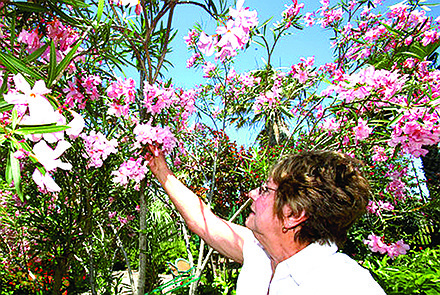The Galveston County Daily News
CALVESTON, Texas-Betty Head remembers stringing oleander blossoms together when she was a young girl growing up in Galveston.
The Galveston County Daily News reports Head, who turns 89 in July, played with neighborhood friends under the fragrant large bushes that once lined many island streets. But many of those bushes are gone because they blocked views of drivers turning corners, she said.
"People complained about them," Head said.
While it's true, as Head admits, that some people just don't like oleanders, the resilient, flowering evergreen shrubs have special status in Galveston and occupy a special place in the hearts of many islanders.
They are the city's official flower, for example, and for some they embody in plant form those things that make islanders different: they are tough, flourishing here when others have failed; they are stately and colorful in bloom; and they can be dangerous if handled incorrectly.
And so it's not by chance that the International Oleander Society is based in Galveston. The group-which aims "to promote, carry on, and aid in every way the development, improvement and preservation of Oleanders of all kinds, including the importation and improvement by cultivation and hybridization of Oleanders," among numerous other similar endeavors-turns 50 this year.
Head has been part of those efforts almost from the beginning, having served in various society posts on and off since she joined it in 1970. She may be to the society what the oleander is to Galveston, and two years ago, the society named a park after her, the Betty Head Oleander Garden Park.
In September, city officials tried to buy an old Dairy Queen property with plans to move the oleander garden to that site. But the negotiations fell through, city spokeswoman Jaree Fortin said.
The city would have entered into an agreement with the Mary Moody Northen Endowment to use the former site of the garden as a parking lot for a new fire and EMS station that will replace Central Fire Station downtown."The thought was to relocate the oleander garden and give it greater visibility and utilize its old location as parking for the new fire station," Fortin said. "However, those negotiations failed, and the city currently has no further plans on this topic."
That is fine with Head, who wants the garden to stay put and unbothered. The garden has moved at least five times already, she said.
The esplanade on Broadway used to be wider and large oleanders filled it, Head said. Now, popular dwarf varieties of oleander grow in city medians instead.
"In any area that any species of plant blocks or impedes traffic or site lines, the city is compelled in its official capacity of public safety to remove said impediment," Fortin said.
Along the Interstate 45 corridor, the state also removed and replaced oleanders that blocked traffic or site lines with dwarf oleanders, Fortin said.
The first oleanders came to Galveston from Jamaica in 1841 aboard a ship that belonged to Joseph Osterman, according to the society's literature. He gave some to his sister-in-law, Isadore Dyer, who grew them, loved them and then shared them with her friends.
Oleanders thrived on the island. The pink and white flowers perfumed a marshy and sometimes smelly settlement, Head said.
After the 1900 Storm that devastated the island, the Women's Health Protective Association began a project to replant oleanders on top of the sand used to raise the grade. The same sand also covered much of the remaining vegetation on the island.
Left to their natural state, oleanders grow tall and bushy, but they adapt well to pruning and trimming if people cut them correctly, Head said.
"People do it at the wrong time," she said. "We say it's better to clip them in the fall."
The early members of the society searched for the earliest oleander varieties grown in Galveston among the more than 100 varieties. Double pinks and single whites were popular ones as well as new varieties that can come into bloom. Oleander experts can spot the different blossom types: large double, buttercup, very large rounded petals, large square ended petals or small square petals resembling a star.
"They cross-pollinate on their own," Head said. "We hunted the island to find them."
Society members named many varieties after specific people, such as the double pink variety known as Mrs. Isadore Dyer.
Another is named the Kewpie Gaido for Maureen "Kewpie" E. Schwerdtfeger Gaido, who founded the society and who cultivated oleanders in her nursery behind Gaido's Seafood Restaurant, Head said.
The society adapted more scientific approaches and became a registrar of the scientific names assigned to varieties. The hardy flowering bush with slender dark-green leaves continues to thrive.
"It's a survivor plant," Head said. "It lasts when others don't."


